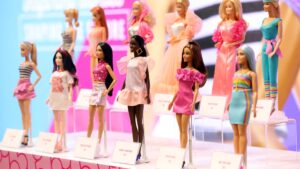Understanding the Impact of Tariffs on Mattel’s Pricing Strategy: What Investors Should Know
The global toy industry is facing significant changes, and at the forefront of this evolution is Mattel, the iconic brand behind beloved products like Barbie and Hot Wheels. Recently, the company disclosed potential price increases for its toys as it navigates a challenging economic landscape marked by new tariffs introduced by the U.S. government.
A Shift in Pricing Strategy
In a recent earnings call, Mattel’s CFO, Anthony DiSilvestro, highlighted the company’s readiness to adapt to these tariffs. With approximately 40% of its toys manufactured in China and less than 10% in Mexico, Mattel is exploring various strategies to mitigate the impact of the 10% tariffs imposed on Chinese goods. One critical strategy involves reassessing its supply chain logistics while also considering passing some of these costs onto consumers through higher prices.
"We do work closely with our retail partners to achieve the right balance," DiSilvestro noted, emphasizing the importance of keeping consumer interests in mind when adjusting prices. This suggests that while price hikes may be on the table, they won’t be implemented without careful consideration of market dynamics.
Economic Context and Implications
This development comes at a time when economists are forecasting that these levies will likely lead to increased retail prices nationwide. The uncertainty surrounding tariffs, especially regarding potential additional duties on imports from Canada and Mexico, creates a precarious environment for retailers. Although an initial 25% tariff was proposed, it has since been paused, indicating that negotiations and adjustments may still play a role in shaping the landscape of international trade.
What’s particularly noteworthy is the broader context of how these tariffs could impact the toy industry, which predominantly sources around 80% of its goods from these regions.
Mattel’s Unique Position
However, not all companies are equally affected—those like Mattel with diversified supply chains stand at a strategic advantage. Mattel operates both its own and third-party factories across seven countries, allowing it more flexibility and opportunities to relocate production if necessary. With a growing emphasis on international markets—about 40% of its sales occur outside North America—Mattel is less tethered to U.S. tariffs than some other competitors.
Looking ahead, Mattel plans to reduce its sourcing from China and Mexico to represent over 25% of its total global production by 2027, showcasing a proactive approach in adjusting its supply chain to respond to changing economic conditions. This can provide investors with a sense of security, knowing that Mattel is not overly dependent on any single market.
Navigating the Future
As Mattel adapts its pricing structure in response to tariffs, consumers and investors alike should remain attentive to market reactions. Pricing decisions will depend heavily on how well Mattel can manage its supply chain and maintain collaborations with retail partners.
At Extreme Investor Network, we believe that understanding these dynamics provides a crucial edge for investors. By staying informed about how shifts in international policy can influence key players in the industry, savvy investors can position themselves to capitalize on opportunities. The evolving landscape around tariffs not only impacts pricing but is indicative of broader shifts in global trade practices, necessitating that investors stay nimble and informed.
Stay tuned for more insights and analyses as we continue to monitor these developments. With proper consideration of these challenges and opportunities, investors can make more informed decisions in the ever-changing business environment.

